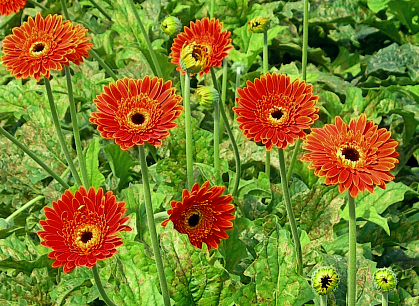
A recent question about missing flower buds brought to mind beautiful gerbera daisies: they are terrific either as cut flowers from the florist or planted in gardens and landscapes. Surprise someone by showing up to plant a few flowers in the garden; they will be delighted every time the plants bloom.
Gerbera daisy is the common name given to Gerbera jamesonii that is native to South Africa. The genus Gerbera, named for the German naturalist Traugott Gerber and the species name jamesonii for Robert Jameson. He, while prospecting for minerals in northeast South Africa, collected specimens in 1884. It was Richard Lynch, who, towards the end of the 19th century in Cambridge, England, crossed the species Gerbera jamesonii and Gerbera viridifolia that produced the plants that are the parents of most of the modern-day varieties.
Gerbera daisies are members of the Asteraceae Family. They grow from a central crown with leaves to 10 inches long that are strongly lobed and hairy with wooly stems. The flowers are born on top of a wooly stem. The flower head consists of a row around the edge of ray flowers with a single petal and center flowers or disk flowers with small or absent petals. The ray flowers provide the color in shades of scarlet, pink, yellow, cream, and orange. Disk flowers are variably colored. In other words, what we call a “daisy flower” is, in reality, a bunch of flowers.
Here are a few pro tips on growing and flowering fabulous Gerberas.
Plant Gerberas where they will receive about 6 to 8 hours of sun. However, excess heat can take its toll. A little afternoon shade is a good thing. Sandy, well-drained soil is a requirement; however, that is only part of the equation. The plant’s crown must be above ground and have enough air circulation to dry quickly after any water event – rain or irrigation.
Supply nutrients regularly. Use a balanced slow-release product every three months or according to the label or a granular or liquid product gently every month during the growing season, February-November for central and south Florida gardens and most warm-season gardens.
Due to Gerbera’s susceptibility to diseases, it is essential to control irrigation – don’t extend the time the plant, particularly the crown, is wet and regularly remove old flower heads and leaves, which can be the source of disease growth and spread.
Another pest issue came in an email from Richard; “I recently planted some gerbera daisies, they were in 4-inch pots, and all had budding flower heads. The next day I noticed that all the flower heads were sheared off and none of the flower heads were eaten. What would cause this problem?”
Caterpillars are the larva or immature form of insects in the Lepidopterous group – moths and butterflies and they tend to be voracious. The caterpillars known as cutworms typically cut off seedlings at ground level, but some cutworms attack flower buds. The adults and worms are generally nocturnal; they tend to burrow in the soil or under debris during the day and feed during the night.
Control options for caterpillars include handpicking, spraying, or waiting for natural enemies to do the job. Handpick is difficult for cutworms unless you head out in the middle of the night with a flashlight. Relatively low toxicity sprays are available in products containing the bacteria Bacillus thuringiensis or BT. The worms ingest the bacteria sprayed on the leaves and soon stop feeding and die as the bacteria multiples and poison them from the inside.
Gift your favorite people with a few sunny gerbera daisies for a bright, happy smile and mood pick-me-up.
Leave a Reply